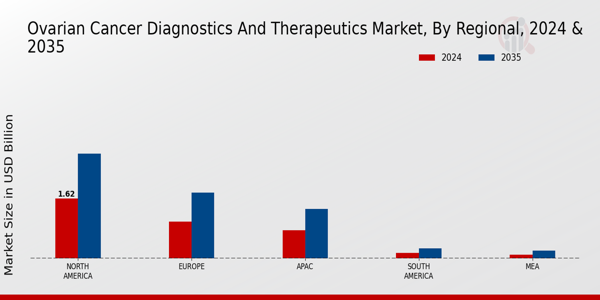Increased Awareness and Education
Increased awareness and education regarding ovarian cancer are pivotal in shaping the Ovarian Cancer Diagnostics and Therapeutics Market. Campaigns aimed at educating the public about the symptoms and risk factors associated with ovarian cancer are gaining traction. As awareness grows, more women are likely to seek medical advice, leading to earlier diagnoses and treatment. This shift is expected to drive demand for diagnostic services and therapeutic interventions. Furthermore, healthcare providers are increasingly incorporating ovarian cancer education into routine check-ups, which may lead to a higher rate of screenings. The emphasis on patient education not only empowers women but also contributes to a more proactive approach in managing ovarian cancer, ultimately fostering market growth.
Rising Incidence of Ovarian Cancer
The increasing incidence of ovarian cancer is a primary driver for the Ovarian Cancer Diagnostics and Therapeutics Market. According to recent statistics, the number of new cases has been steadily rising, with estimates suggesting that approximately 22,000 women are diagnosed annually. This alarming trend necessitates the development of advanced diagnostic tools and therapeutic options, thereby propelling market growth. As awareness of ovarian cancer symptoms improves, more women seek medical attention, leading to earlier diagnoses. Consequently, the demand for innovative diagnostic solutions, such as imaging techniques and biomarker tests, is expected to surge. This growing patient population creates a robust market environment, encouraging investments in research and development to enhance treatment modalities and improve patient outcomes.
Growing Investment in Cancer Research
The surge in investment for cancer research is a crucial driver for the Ovarian Cancer Diagnostics and Therapeutics Market. Governments and private organizations are allocating substantial funds to develop novel diagnostic and therapeutic solutions. For instance, funding for ovarian cancer research has seen a marked increase, with millions of dollars directed towards understanding the disease's biology and improving treatment options. This influx of capital fosters innovation, enabling researchers to explore new biomarkers and therapeutic targets. Additionally, collaborations between academic institutions and pharmaceutical companies are becoming more prevalent, further accelerating the pace of discovery. As research progresses, the introduction of new diagnostic tools and therapies is anticipated, thereby enhancing the market landscape and providing patients with more effective treatment options.
Technological Advancements in Diagnostics
Technological advancements in diagnostic methodologies are significantly influencing the Ovarian Cancer Diagnostics and Therapeutics Market. Innovations such as liquid biopsy and next-generation sequencing are revolutionizing how ovarian cancer is detected and monitored. These technologies allow for non-invasive testing, which is increasingly preferred by patients and healthcare providers alike. The market for liquid biopsy alone is projected to reach several billion dollars by 2026, reflecting the growing reliance on advanced diagnostic tools. Furthermore, the integration of artificial intelligence in imaging and pathology is enhancing the accuracy of ovarian cancer diagnoses. As these technologies continue to evolve, they are likely to improve early detection rates, thereby increasing the demand for therapeutic interventions and contributing to overall market expansion.
Regulatory Support for Innovative Therapies
Regulatory support for innovative therapies is emerging as a significant driver in the Ovarian Cancer Diagnostics and Therapeutics Market. Regulatory bodies are increasingly recognizing the need for expedited approval processes for breakthrough therapies and diagnostic tools. Initiatives such as the FDA's Breakthrough Therapy Designation are designed to facilitate the development of promising treatments for ovarian cancer. This regulatory environment encourages pharmaceutical companies to invest in research and development, knowing that their innovations may receive faster market access. As a result, the introduction of novel therapies and diagnostics is likely to accelerate, meeting the urgent needs of patients. This supportive regulatory framework not only enhances the market's attractiveness but also fosters a culture of innovation within the industry.


















Leave a Comment